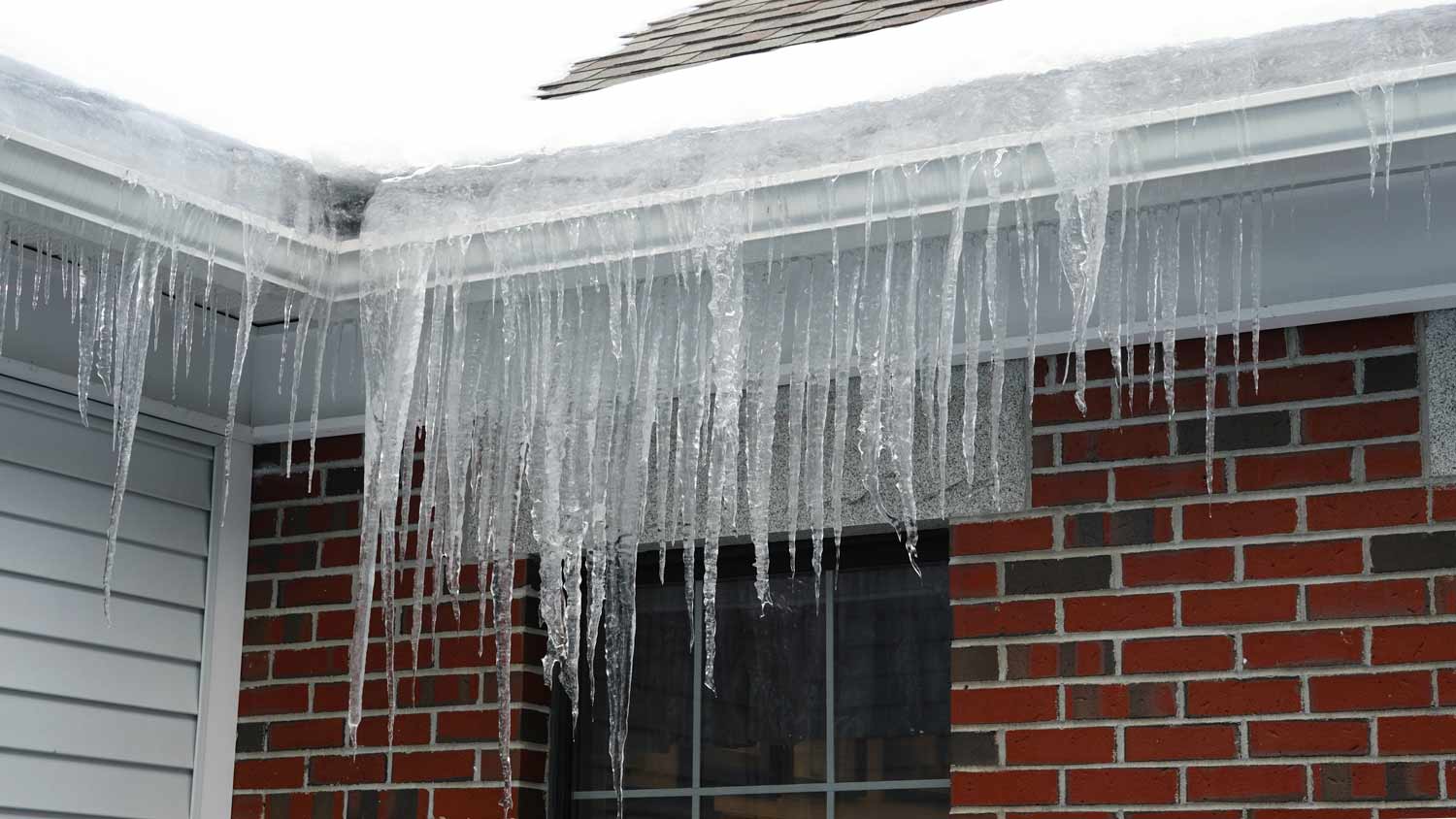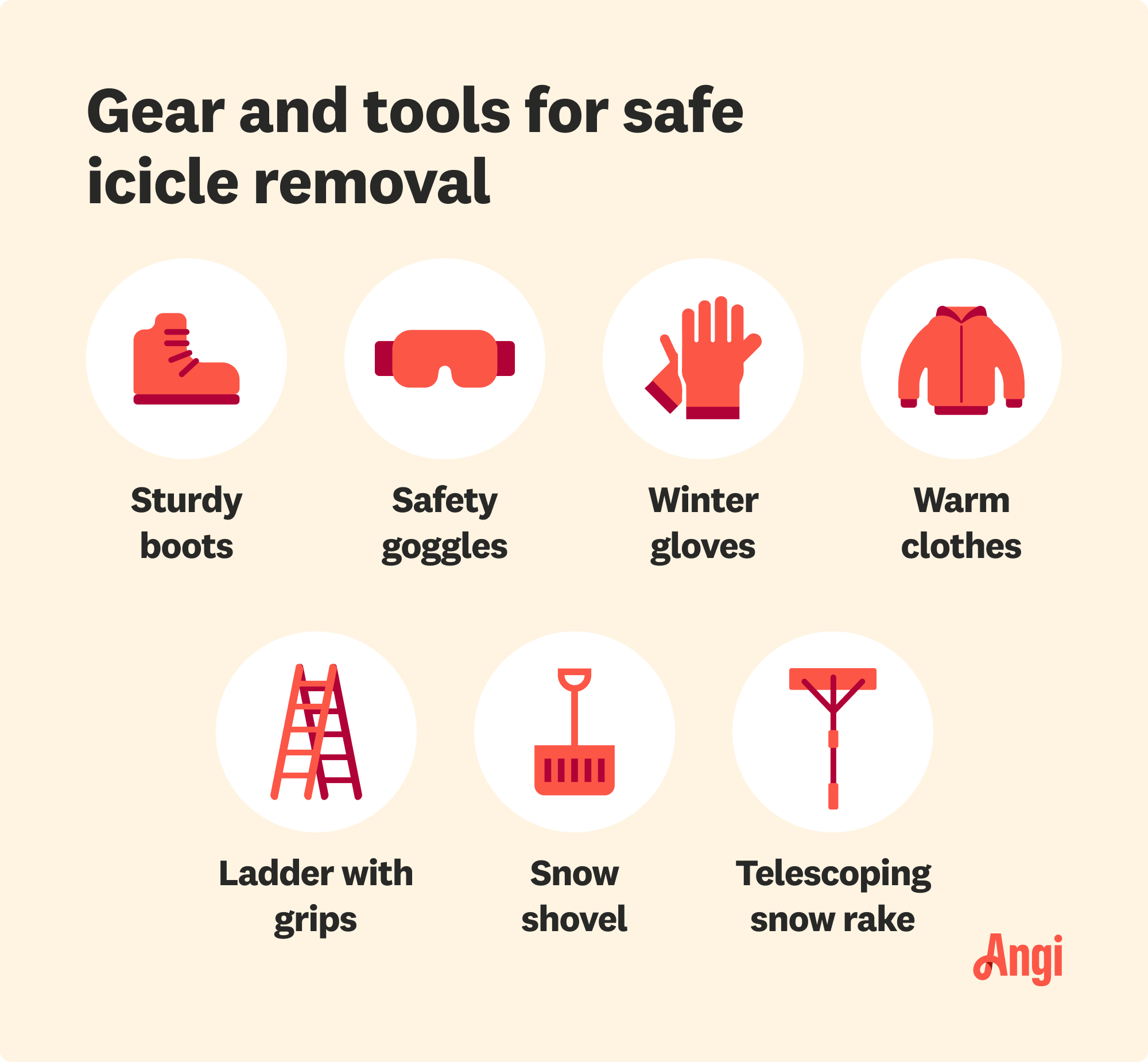Breaking the Ice: Should You Knock Down Icicles?
Get the details on handling these sparkling winter formations


Icicles form when water freezes as it drips off the roof.
Icicles can damage your house or pose a risk of injury if they fall from the roofline.
Proper attic insulation and ventilation can prevent most damage from icicles.
A falling icicle can pierce like a sword and reach weights that bend gutters. But should you knock down icicles? Before you start smashing these sparkling spears, read about potential issues with icicle removal and how you can potentially prevent them from forming in the first place.
Why Do Icicles Form?
If you’re wondering why icicles form on your roof, you might be surprised to know that small trickles form these sharp pieces. Snow on your roof slowly melts once temperatures rise above freezing. Even in freezing temperatures, you can get runoff if the attic gets warm enough to heat areas of the roof.
Melting snow doesn’t come off in a torrent. Instead, it trickles down in a drip, drip, drip. In freezing temperatures, those drips of water freeze as they reach cooler air. Before you know it, you’ve got beautiful icicles on your home’s exterior.
If left unchecked, icicles will continue to grow as long as the weather conditions are right for a slow thaw followed by a quick freeze. However, you only need to remove them if they pose a danger to your home, like damaging gutters or falling on people as they enter your home. In areas where below-freezing temperatures can stick around for weeks or months, you may need to invest in aggressive snow and ice management or sign a contract with a snow removal company.
Are Icicles Bad for My Roof?

Icicles can get large and heavy, and in some cases, they can damage your house by bending or breaking gutters away, so icicles can be bad for your roof. The ice may also extend under shingles, causing them to peel away from the roof. Icicles can also break off and damage the surrounding property or, in worst-case scenarios, hurt someone.
These magical winter formations can also indicate deeper problems with your home. Icicles can form when ice dams develop in your gutters and at the edge of your roofline. Ice dams block gutters, backing up water onto the roof. Standing water may freeze and damage shingles, leak into the attic, or run down walls. Ice dam removal is a tricky, dangerous business, and it’s best to consult with an ice dam removal company or specialist.
Should You Knock Down Icicles Yourself?
Whether you should knock down icicles yourself depends on your situation. For instance, the size of the icicles and your physical ability will affect whether you should do this task yourself. If you’re physically able and prepared to take proper safety precautions, then you should be able to knock down icicles yourself. However, if the icicles are particularly large or sharp, it may be best to hire a roof cleaner to do it for you.
Tips for Safe Icicle Removal

Icicle removal is no laughing matter, as these formations can easily hit someone if they fall. The cold and often icy conditions that accompany icicles create additional safety hazards, like slippery surfaces. The following tips can help you stay safe while removing icicles.
Dress for the Weather
Wear warm, sturdy boots with aggressive tread to give you good traction on slippery surfaces. Put on safety goggles in case ice or snow falls on top of you, and wear warm clothes for the weather conditions and warm gloves to protect your skin from frostbite.
Stay on the Ground
Roofs can be extremely slippery in the winter. Stay off of the roof for icicle or snow removal or call a snow removal pro if getting on the roof is your only option. Use a ladder with strong grips on the legs to access the gutters. Place the ladder on flat ground, and clear the area of snow and ice for better stability.
Climbing on a slippery, snowy, or icy roof can lead to injury. Stay safe, and consider calling a snow removal pro to do the job.
Use the Right Tools
Use a telescoping roof rake to pull snow from the roof. You can extend the rake’s handle so you can pull snow and ice off the roof from a distance. Do not stand directly under the icicles when removing them; otherwise, a falling icicle poses a risk of injury to you or others.
Snow rakes are best for icicles less than 1 inch wide and 1 foot long. However, before attacking the icicles, soften the ice with either warm water or ice-melting tablets by putting them in an old pair of pantyhose. To melt ice in the gutters, lay the hose perpendicular to the gutter and let it hang over. The hose can help contain the tablets, so they are less likely to cause roof damage. However, be aware that there’s still a chance the tablets will cause rust or discoloration.
Warm water is the other option, but getting it into the gutters can be difficult. Be careful so you don’t drop warm water on yourself. Once the snow has softened, you can use the rake to gently break away the icicles.
Remove Snow ASAP
As far as when to remove snow from the roof, do so as soon as possible after a heavy snowfall. That could be the next day or a few days later if inclement weather sets in. The longer the snow stays on your roof, the more time it has to thaw and freeze again, forming more icicles.
How Much Does Snow Removal Cost?
Icicle removal can be a tricky business. You can easily damage your roof or gutters during the process. Unless you’ve got an ice dam situation, it’s often best to leave the icicles until warmer weather naturally melts them away. It’s only necessary to remove them if they get heavy enough that they pose a danger to your home or those entering your home.
The other option is to call a local roof cleaner that can use steamers and other devices to loosen the ice for safe removal. For those living in areas prone to problematic icicles throughout the winter, and wondering about the average cost of roof snow removal, you can sign a yearly contract with professional snow removers for somewhere between $200 and $600 per season.
That’s a relatively small price to pay for your own safety and the safety of your home. It might be worth getting a few quotes to give yourself some piece of mind come wintertime.
How to Prevent Icicles
You probably can’t prevent all icicles, but you can reduce their occurrence and learn how to prevent some icicles with basic home maintenance. Clean your gutters regularly to prevent clogs that cause water to back up in the gutters.
Stay on top of snow removal. Less snow on the roof means less melting water will drip off the sides. Use a snow rake to remove snow from the roof as soon as possible. Make sure to follow the slope of the roof to prevent shingle damage.
You can also consider adding roof heating cables to your roof to minimize icicles, though the cost of roof heating cables is higher than just committing to regular maintenance. Plus, with the potential danger of roof heat cables in question you definitely want to make sure they are installed professionally and safely.
Prevention also involves what’s going on inside your house, or in this case, the attic. Inadequate attic insulation can lead to warm air heating up the attic space and melting snow in some areas of the roof but not others. That water runs to the edge of the roof, where it freezes when it hits colder air, and it can then create icicles or ice dams.
Inspect your attic insulation, which should be about 1 foot thick. Areas of light peeking through the insulation are indications that you could use more protection. You can also weatherproof your attic hatch to prevent warm air from seeping up from your main living space.
Adequate ventilation at the ridge and soffits can also help keep the attic cool and prevent snow melt. You might need to increase ventilation under the ridge or eaves to allow more cool air to circulate under the roof. Lastly, you may want to factor in the cost of replacing or adding a drip edge to the roof. A drip edge provides flashing that helps manage water flow and prevent roof and structural damage.
How Often Should You Remove Icicles?
The good news is a few small icicles don’t pose as much of a hazard. If that’s all you’ve got, just wait out the cold weather. However, if you’ve got icicles nearing the 1-foot mark, and they’re over areas where people enter and leave your home or business, it’s best to address the situation to avoid an accident.
The frequency with which you remove them will depend on the climate, the weather in your area, and the temperature stability of your attic. In areas where snowfall is frequent and temperatures rise above freezing during the day only to drop again at night, you will probably need to remove icicles regularly. That could mean every couple of weeks or even more often if there’s heavy snowfall.
Frequently Asked Questions
No, removing icicles doesn’t prevent ice dams. This is because the icicles themselves are a product of ice dams, so removing them won’t actually prevent the problem unless you remove the ice dam in full. That being said, removing icicles makes it easier to clear snow from your roof, which will help mitigate ice dam production.
Icicles don’t necessarily mean that your gutters are bad. However, they do cause major issues for your gutters. For example, the weight of the ice in your gutters can rip them off the house completely.
Icicles on your roof are not always a sign of a bigger problem, but they can be. While a few here and there are pretty standard, if your roof is accumulating a lot of icicles, it may be a sign that it has poor insulation.
















